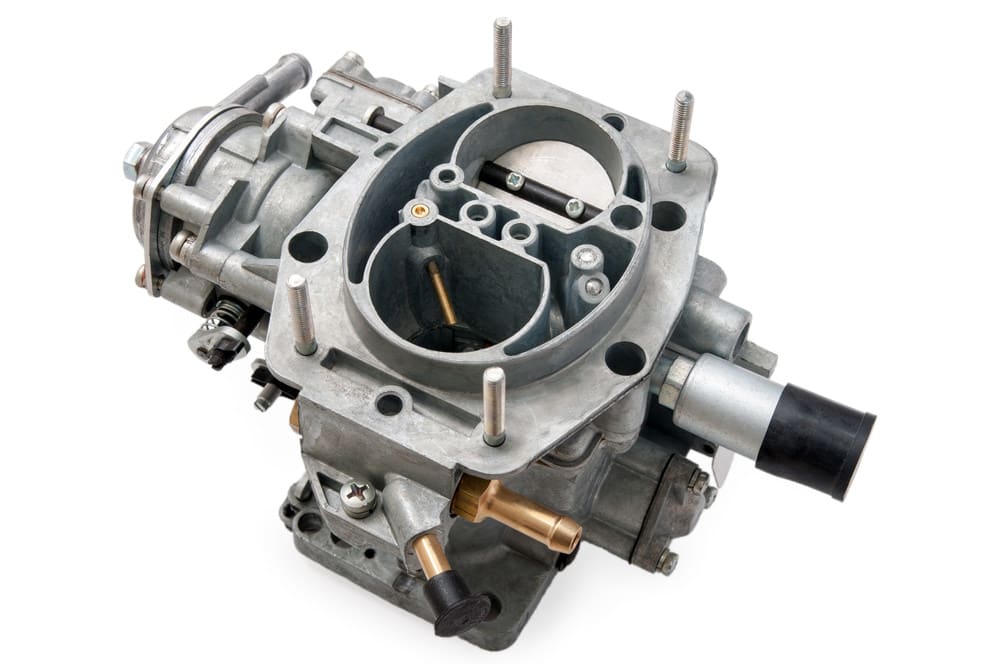

The carburetor is responsible for mixing gasoline and air together in just the right amounts and getting that mixture into the cylinders. Though they are not found in new cars, carburetors have delivered fuel into the engines of every vehicle from legendary race cars to top-end luxury cars. They were used in NASCAR up until 2012 and many classic car enthusiasts use carbureted vehicles every single day. With that many die-hard enthusiasts, carburetors must offer something special to those who love cars.
How does a carburetor work?
A carburetor relies on the vacuum created by the engine to draw air and fuel into the cylinders. This system was used for so long because of the simplicity behind it. The throttle can open and close, allowing either more or less air to enter the engine. This air moves through a narrow opening called a venturi. The vacuum is a result of the airflow required to keep the engine running.
To get an idea of how a venturi works, picture a river flowing normally. This river is moving at a steady pace and the depth is very consistent for the entire length. If there is a narrow section in this river, the water will have to speed up for the same volume to get through at the same depth. Once the river returns to the original width after the bottleneck, the water will still try to retain that same velocity. This makes the higher-velocity water on the far side of the bottleneck pull on the water approaching the bottleneck, creating a vacuum.
Thanks to the venturi, there is enough of a vacuum inside of a carburetor for the air passing through it to steadily draw gas from the jet. Found inside of the venturi, the jet is an opening where fuel from the float chamber can mix with air before entering the cylinders. The float chamber holds a small amount of fuel, like a reservoir, and allows fuel to easily flow to the jet as it is needed. As the throttle opens, more air is drawn into the engine, bringing with it more fuel, which makes the engine create more power.
The main issue with this design is the fact that the throttle has to be open for the engine to get fuel. The throttle is closed at idle, so an idle jet allows a small amount of fuel to enter the cylinders to keep the engine from stalling. Other small issues include excess fuel vapor escaping the float chamber(s).
In the fuel system
Carburetors have been made in a number of shapes and sizes over the years. Small motors may just use a single carburetor with a single jet to get fuel into the engine, while larger motors can use as many as twelve jets to stay in motion. The tube containing the venturi and jet is called a barrel, though this term is usually only used when referring to multi-barrel carburetors.
Multi-barrel carburetors were a big selling point for cars in the past, with options like 4 or 6-barrel configurations. More barrels meant more air and fuel could enter the cylinders. Some engines even used multiple carburetors.
Sports cars often came from the factory with one carburetor per cylinder, much to the dismay of their mechanics. These would all have to be individually tuned, and the temperamental (usually Italian) power plants were particularly sensitive to any imperfections in tuning. They also had a tendency to need tuning fairly often. This is a big reason why fuel injection was popularized with sports cars first.
Where have all the carburetors gone?
Since the 1980s, manufacturers have been phasing out carburetors in favor of fuel injection. Both do the same job, but complex modern engines simply evolved past carburetors and the much more precise (and programmable) fuel injection has taken over. There are a few reasons for this:
Fuel injection can deliver fuel directly into the cylinder, though sometimes a throttle body is used to let one or two injectors deliver fuel to multiple cylinders.
Idling is tricky with a carburetor, but it is very simple for fuel injectors. This is because a fuel injection system can just add a small amount of fuel into an engine to keep it going, but a carburetor has the throttle closed at idle. An idle jet is required to keep a carbureted engine from stalling with the throttle closed.
Fuel injection is more precise and wastes less fuel. There is less gas vapor with fuel injection because of this as well, so there is less chance of fire.
Despite being outdated, carburetors are a big part of automotive history and operate in a purely mechanical and clever way. By working with carbureted engines, enthusiasts can get hands-on knowledge of how air and fuel is brought into an engine to be ignited and keep everything in motion.



